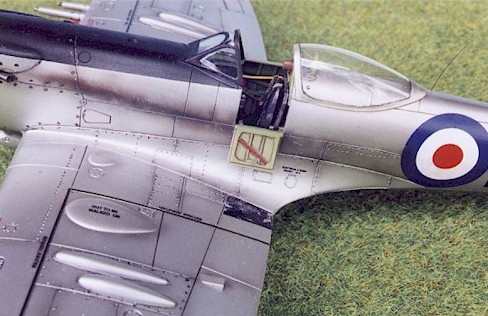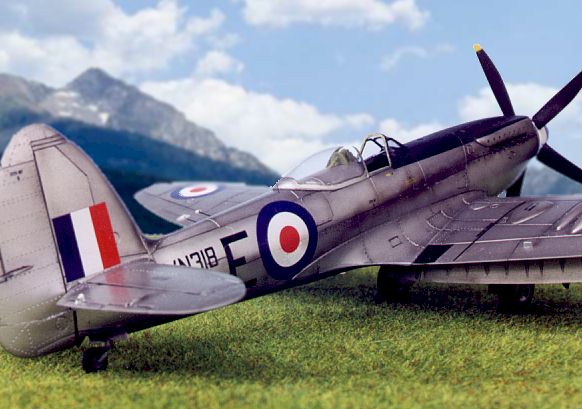|
Supermarine
Spitfire F24 |
|
Supermarine
Spitfire F24 |
two more images in text and four more at the bottom of the page
B a c k g r o u n d |
The Supermarine Spitfire was the only Allied fighter aircraft to see front-line service
for the entire period of the Second World War, and well into the post-war period. During
this interval it underwent vast modifications.
The Spitfire Mk. I in 1939 was powered by a V-12 Rolls Royce Merlin III engine rated at 990 horsepower, driving a two or three bladed propeller. These first Spitfires were graceful and streamlined with an almost delicate appearance, featuring rounded control surfaces and a semi-elliptical wing. Armament was powerful for its time - eight wing-mounted Browning .303 machine guns. The early Spitfire was a natural dogfighter and very fast compared to its contemporaries.
By 1947, the F22/24 had little in common with these early Spitfires other than the name. A 2,050 hp Griffon 61 engine was cowled in a bulged forward fuselage driving a big five bladed (or even six bladed counter-rotating) propeller. The rear fuselage was cut down with a clear-vision bubble canopy over the cockpit. The wing was a totally new design, as were the tall tail surfaces and revised horizontal stabilisers. Most of the structural changes were necessary to restore the Spitfire's excellent handling that was being progressively eroded by its increased weight, length and power.
Main armament was four Hispano 20mm cannon. This late Spitfire could also carry under-wing stores consisting of either eight rockets or up to 1000 lb. of bombs. Top speed was 454 mph.
The F22/24 looked very much like a Spitfire on steroids. It was one third faster than its earliest ancestor, possessed twice the rate of climb and its fully laden weight was almost double the empty weight of a Mk. I!
Only 81 Spitfire F24s were delivered in the dawning jet-age.
I n t h e B o x |
Airfix has come a long way in the last decade. Ten years ago, it appeared that they were
locked into a 1960’s mentality of raised panel lines, basic detail and an apparently
endless re-release programme.
Airfix’s products today feature accuracy, detail and surface texture to rival the best offerings from Japan and the USA. The Spitfire and Seafire kits were amongst the first indicators of the true potential of Airfix in the mid to late 1990s after some so-so 1/48 releases during the 1980s and early 1990s. This potential has been further reinforced with their magnificent new Lightning kits. It is particularly pleasing that Airfix have concentrated on otherwise overlooked postwar British aircraft in 1/48 scale.
The Spitfire F22/24 is a relatively simple kit. It comes packed in a long, rigid box. 90 parts are provided on 2 sprues of medium grey coloured styrene and 1 separately bagged sprue of clear. The plastic is not too brittle and not too soft - very "Tamiya" in look and feel.
Surface detail is crisp. Details such as panel lines are engraved where appropriate. The engine cowling fasteners are particularly well done. The only nitpick is that the solid moulded "undercarriage-down" indicators on the upper surfaces of the wings are a little heavy handed.
Parts' breakdown and engineering is sensible and "modeller friendly". Even sprue attachment points are thoughtfully placed. For example, on the lower fuselage halves the sprue is attached to the camera-port cutout and on the forward nose section (which is covered by the one-piece lower cowl cover). Neither of these connector positions is visible on the completed model, thus eliminating the risk of visible sprue cut marks.
Options include camera port; rocket armament; positionable flaps and cockpit door; and short or long Hispano cannon barrels. The counter-rotating propeller assembly and shorter tail seen on some early Mark 22s are not included in this kit. However, if you are really keen this may be a potential "kitbashing" project in conjunction with the Airfix Seafire kit.
Instructions comprise of a twelve page stapled booklet with a brief history and five pages of exploded view diagrams over eighteen steps. A large decal sheet provides markings for two Mk. 22s and one Mk. 24. One of the painting options is for an overall silver aircraft. My decals were slightly out of register.
C o n s t r u c t i o n |
This was another joint project between Chris Wauchop and myself. I built the model and
Chris undertook the painting and decaling as a commission for one of Chris’s
customers.
 Construction commences in the cockpit. The cockpit is adequate
out-of-the-box, but I decided to add some detail. Curiously, the spade-grip on the control
column is moulded solid. I drilled this out. The seat sides looked a little thick so they
were sanded thinner and brass harnesses from Airwaves were added. Fusewire was used to
represent electrical wiring and the oxygen line. Throttle and quadrant handles were built
from .050 inch plastic rod. Extra panels and small levers were formed from scrap brass.
Finally, after painting of the major cockpit components, I added a drop of epoxy glue to
each instrument representing lenses.
Construction commences in the cockpit. The cockpit is adequate
out-of-the-box, but I decided to add some detail. Curiously, the spade-grip on the control
column is moulded solid. I drilled this out. The seat sides looked a little thick so they
were sanded thinner and brass harnesses from Airwaves were added. Fusewire was used to
represent electrical wiring and the oxygen line. Throttle and quadrant handles were built
from .050 inch plastic rod. Extra panels and small levers were formed from scrap brass.
Finally, after painting of the major cockpit components, I added a drop of epoxy glue to
each instrument representing lenses.
The propeller assembly features keyed individual blades that are inserted into the spinner base plate. The blades are admirably thin and the assembled propeller and spinner capture the look and feel of the big Griffon-engined original in exactly the way that the Academy offering does not!
Assembly of the fuselage revealed a few minor gaps around the cylinder-head bulges and the air intake.
The one-piece lower wing sets the correct dihedral angle. The "gull wing" effect looks slightly underdone - although this may be correct for the revised wing of the later model Spitfires (I could not find a picture to confirm or deny).
The join between the upper wing and fuselage wingroot is excellent, as is the fit of all other major components. The only really poor fit is the camera window option in the lower fuselage of the Mk. 24. This is a cutout, and I neglected the universal rule of "cut less or pay the price in putty"!
The rudder assembly snaps into place. There is almost no need for cement. However, the actuator fouls with the lower part of the rudder - slight trimming is required.
Drilling out exhaust stacks and gun barrels, and adding a whip antenna completed the construction.
P a i n t i n g a n d M a r k i n g s |
Chris Wauchop painted the model. It was finished as one of the final front-line Spitfires
which was transferred from 80 Squadron RAF to the Hong Kong Auxilliary Air Force in 1952.
It is depicted just before the final Spitfire fly-past in Hong Kong during April 1955.

The Testors/Aztek airbrush was used to spray the simple paint finish with Tamiya Silver Enamel (X-11) as the overall colour. Panel lines received a thin wash of Tamiya Acrylic X-18 Semi-Gloss Black. They were then lightly oversprayed with the same colour.
Decals are from Aeromaster sheet no 48-297 "Spitfires: The End of the Line". No problems were encountered.
By the way, if you haven't visited Aeromaster's web site yet you should. It has inventory searches by aircraft type, scale and nationality. Once a subject has been selected, there are thumbnailed images of the decal instructions which can then be viewed at full size. Aeromaster's site can be visited at
A sprayed coat of Gunze Acrylic Gloss completed this simple but striking project.
C o n c l u s i o n |
Airfix’s Spitfire is a great model by any standards. It is an interesting subject, it
is accurate, is straightforward and simple in parts' breakdown, it fits well and looks
good when completed. If you are finding it difficult to remember the last time you
actually finished a model, this is a nice, easy "quick-build" project.
R e f e r e n c e s |
There is no shortage of reference material on the Spitfire. Here are a couple of my
favourites. They do not all cover the Mk. 24, but they are interesting and useful
nevertheless:
"The Spitfire Story - Revised Second Edition" by Alfred Price, Arms and Armour Press, London, 1995
ISBN 1-85409-305-3
This book has a good commentary, statistics and plenty of interesting pictures. Coverage of later marks is better than most other references"Spitfire - a Complete Fighting History" by Alfred Price, Treasure Press, Sydney, 1994
ISBN 1-85648-015-1
Another good reference for late Spitfires. Surprisingly little cross-over between this and the above book by the same (very authoritative Spitfire) author"Aero Detail No. 8 Spitfire Mk I-V" by Shigeru Nohara and Hajimi Ohsato, Dai Nippon Kaiga, Tokyo, 1993 (No ISBN)
Model Art Special No. 387 Supermarine Spitfire (No ISBN)
"Spitfire - The Canadians" by Robert Bracken, The Boston Mills Press, Ontario, 1995
ISBN 1-55046-148-6
This is a terrific book combining first-hand accounts from Canadian Spitfire pilots with excellent photographs and 41 colour renderings. The Mk. 24 is described, but no photos in this volume. I understand there is another book by this author to follow.
R e l a t e d W e b S i t e s |
There are also a number of sites with good Spitfire coverage:
"The Spitfire Shop" This is a very nice idea. A bookshop and model shop with
the theme of Spitfire. Check out the modelling section which links accessories to
available kits.
http://www.users.globalnet.co.uk/~tucker01/index.htm
"The Spitfire Home Page and Spitfire Information Resource" contains
background on the various Marks (with photographs) and information about currently flying
Spitfires:
http://www.ncl.ac.uk/~nsgg/s_soc1.htm
Jeffrey Ethell's perspective on flying the Spitfire is at
http://www.airspacemag.com/ASM/Web/Special/Ethell/pirep2.html
"Spitfire is 60!" web pages providing a chronological history of the Spitfire
on Delta's aviation site:
http://www.deltaweb.co.uk/spitfire/index.htm
Model by Chris Wauchop and Brett Green
Text and Photographs Copyright 1998 by Brett Green
This Page Created 17 May 1998
Last updated 26 July 2007
Back to HyperScale Main Page
Back to Features